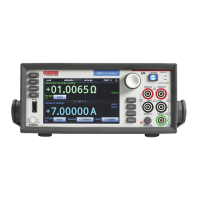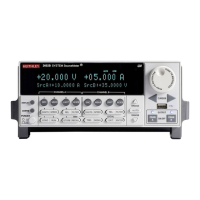2400 Series SourceMeter
®
User’s Manual Pulse Mode Operation (Model 2430 only) 5-9
Pulse energy limitations (10A range)
Energy for pulses are provided by an internal bank of capacitors. Each pulse consumes
energy from the capacitors. After a pulse is generated, the capacitors begin to recharge.
The next pulse will occur at the configured time as long as the capacitors have had enough
time to recharge. If the capacitors are not charged enough to provide the pulse, the instru-
ment will wait until the necessary charge energy is available.
Charge energy consumption by a pulse depends on the pulse current and pulse width, and
is expressed as follows:
Q = I × t
Where: Q is the charge energy consumed by the pulse
I is the pulse current
t is the output on-time (pulse width)
From the above equation, high current and/or long output on-time results in high energy
consumption, and therefore, longer charge time for the capacitors.
On all but the 10A range (source or measure), charge energy consumption is low enough
to allow the capacitors to recharge before the next pulse is due. This fast recharge process
allows the configured pulse period to be consistent (jitter free).
On the 10A range (source or measure), the configured pulse period will be consistent as
long as the pulse duty cycle is 8% or less. Above 8%, the capacitors will not be able to
recharge sufficiently before the next pulse is due. As a result, the pulse period becomes
longer (due to additional charge time between pulses) and more inconsistent (jitter).
To achieve a consistent pulse period on the 10A range, set a pulse off-time that will pro-
vide a duty cycle that does not exceed 8%. For example, if the pulse width is 2msec, the
required off-time is calculated as follows:
Pulse Off-time = (Pulse Width / Duty Cycle) - Pulse Width
= (2msec / 8%) - 2msec
= 25msec - 2msec
= 23msec
If a consistent pulse period is not required for your test, the 10A range allows you to out-
put fast, high energy (>8% duty cycle) pulses. With the pulse delay set to 0sec, each subse-
quent pulse will output as soon as the capacitors become sufficiently charged.
Artisan Technology Group - Quality Instrumentation ... Guaranteed | (888) 88-SOURCE | www.artisantg.com

